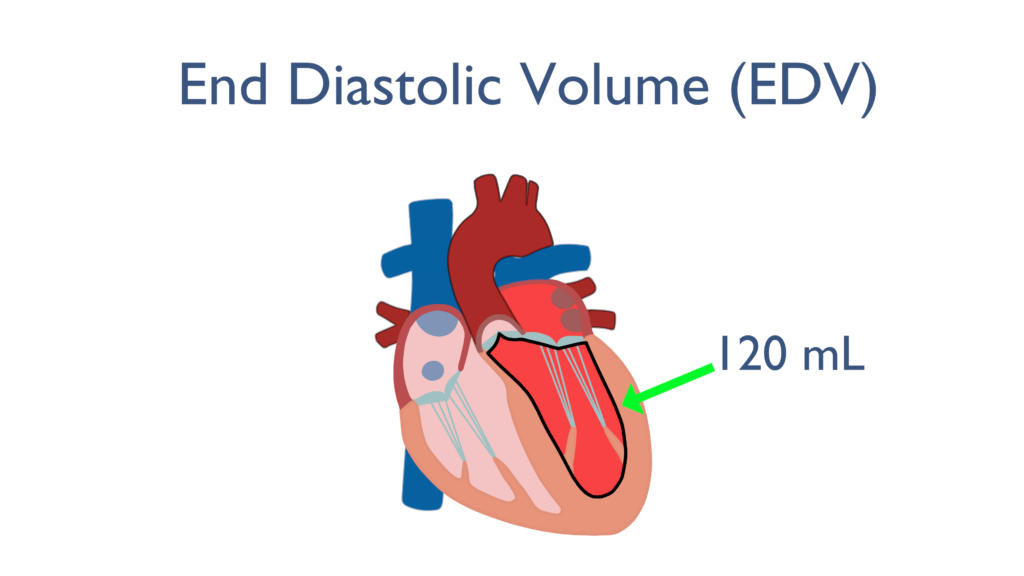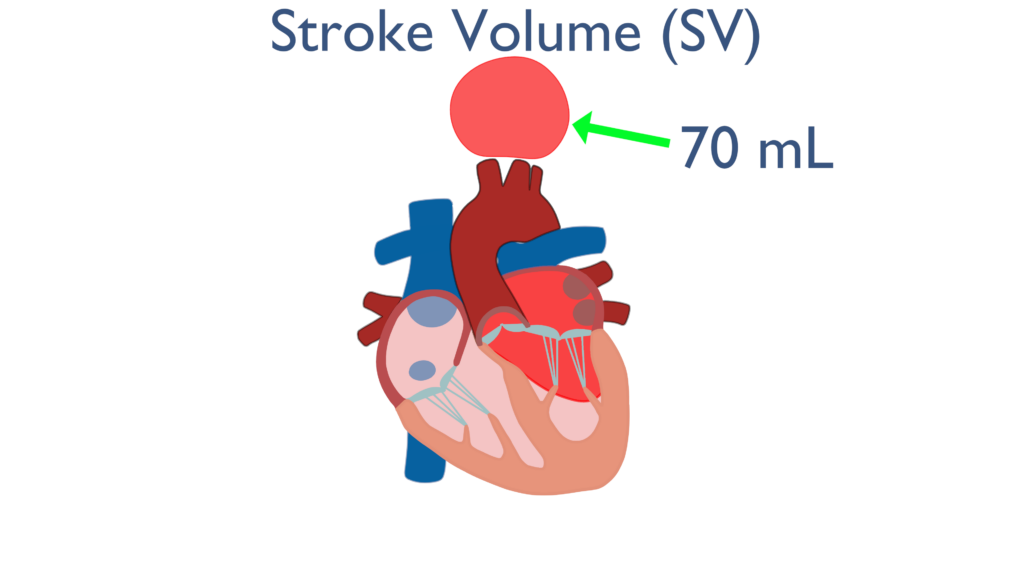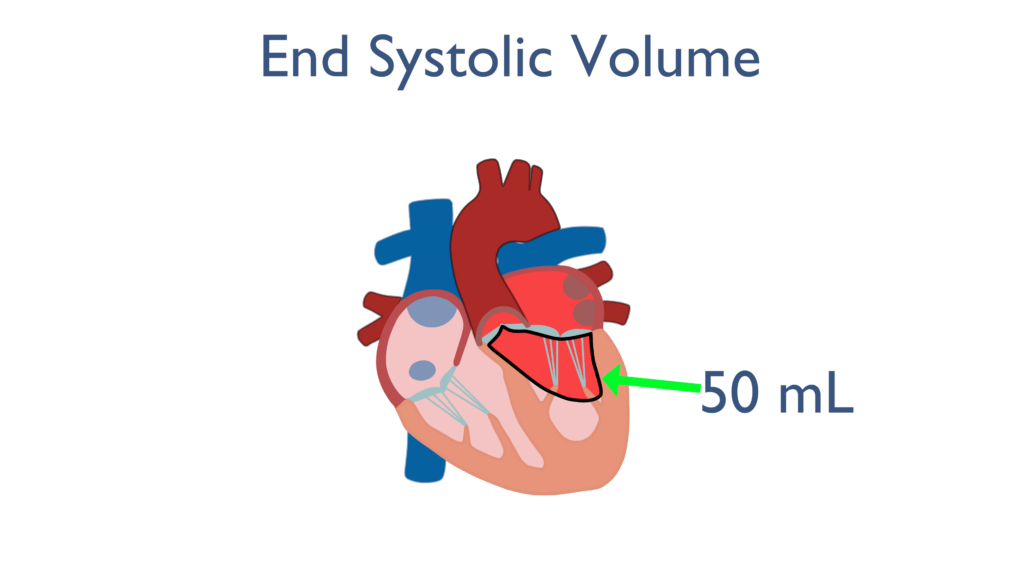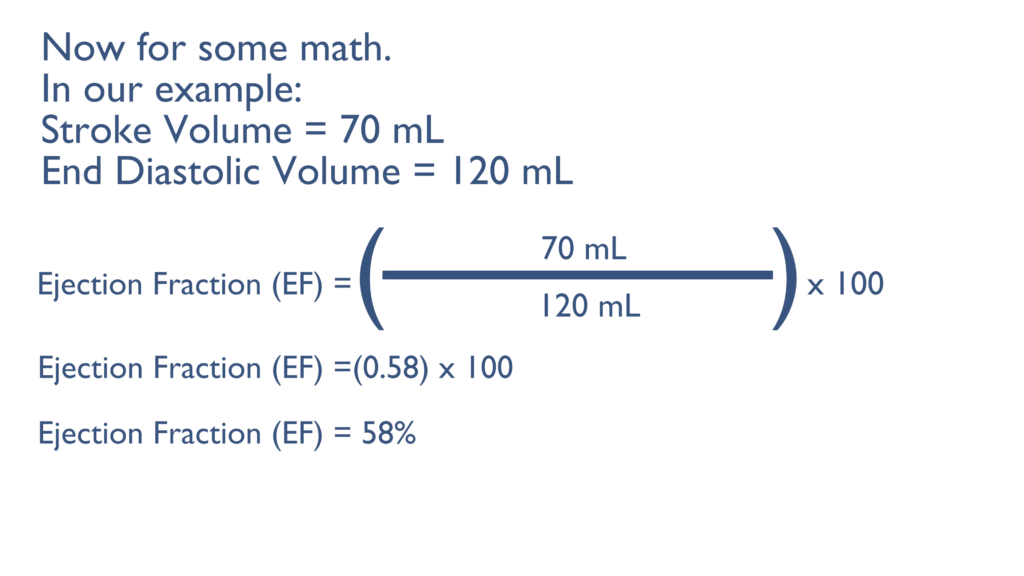Video
Definition
Ejection fraction (EF) is the percentage of blood ejected from the ventricle during ventricular contraction relative to the amount of blood in the ventricle during preload i.e., End Diastolic Volume (EDV) (See Cardiac Output for more information on preload). This is most often specified as Left Ventricular Ejection (LVEF) since the left ventricle is responsible for the movement of blood throughout the body i.e. systemic circulation.
As the ventricle contracts it is near impossible for the left ventricle to eject all blood within it into systemic circulation. This means that EDV will always be greater, and not equal to, SV. So, when we talk about EF we are talking about the percentage of blood being pumped out of the Left Ventricle with each beat
If you recall from the Cardiac Output stroke volume (SV) is defined as the amount of blood ejected from the ventricle with each beat. This means that EF is the ratio of Stroke Volume (SV) to End Diastolic Volume (EDV) .
To calculate EF we first divide SV by EDV and then multiply this result by 100. The equation is given below:

There are five categories used to describe EF in the clinical setting. The 5 categories used to describe EF are hyperdynamic, normal, mild dysfunction, moderate dysfunction, and severe dysfunction (Kosaraju et. al., 2023).
End Systolic Volume (ESV)
When it comes to EF there is one more volume of blood to consider. This is End Systolic Volume.
End Systolic Volume (ESV) is the amount of blood that is still present in the ventricle after the ventricle have contracted and ejected blood into systemic circulation.
This is the difference between End Diastolic Volume and Stroke Volume.
Walkthrough
To understand EF it is imperative to understand EDV, SV, and ESV. Below these three volumes will be described and then mathematically used to calculated EF.

First, the ventricle fills with blood from relaxation and atria contraction. The amount of blood in the ventricles at the end of atrial contraction and just before the ventricles contract is known as End Diastolic Volume (EDV).
EDV on average is 120 mL.

As the left ventricle contracts a portion of blood that was in the ventricle is ejected out into systemic circulation. This portion of blood is known as Stroke Volume (SV).
SV can be calculated by subtracting ESV from EDV.
SV on average is 70 mL.

End Systolic Volume (ESV) is the volume of blood left in the ventricle after Stroke Volume (SV) has been ejected.
ESV is equal to EDV – SV. Therefore here ESV is 50 mL since EDV is 120 mL and SV is 70 ml.

Ejection Fraction (EF) is the percentage of End Diastolic Volume (EDV) that is ejected from the left ventricle.
This is to say that it is the ratio of Stroke Volume (SV) to End Diastolic Volume (EDV).
Using the volumes depicted above the equation here shows how EF was calculated.
So what?
Cardiac disease is a leading cause of death world wide. Left Ventricular Ejection Fraction (LVEF) is a metric used to determine how well the left ventricle is working. This metric is directly related to cardiac mortality risk. This means that the lower the LVEF the more at risk someone is to dying from cardiac causes.
Decreases in LVEF are used to indicate the severity of heart failure. LVEF is directly related to heart failure, which is to say the worse LVEF is the worse the heart failure is.
At times you may notice that someone may have heart failure with preserved LVEF. This means that while this patient clinically has heart failure, their left ventricle is still working appropriately, or just a bit better than expected.
Echocardiogram is the preferred method to calculate LVEF in a clinical setting.
An LVEF less than 30% is an indication that a pacemaker or an implantable cardioverter defibrillator will be needed. This is probably the most important concept to understand regarding LVEF.
A decreased LVEF may also provide clinical insight regarding valve replacement in patients who have valvular heart disease.
While LVEF may provide clinical insight into treatment options for different causes of heart disease it should always be clinically correlated with the specific patient conditions.
Lastly, LVEF may be tracked in a clinical setting to ensure that heart function is not decreasing. Some chemotherapy drugs have cardiotoxic properties which indicate LVEF tracking to ensure the chemo drugs are not inducing heart failure.
Another indication for tracking LVEF is post MI. After an MI it is important to ensure that the heart continues functioning optimally. As we know, with an MI cardiac tissue may begin to die. Myocardial cellular death can lead to a decreased LVEF, which can be an indication to monitor cardiac function via the monitoring of LVEF.
References
Kosaraju, A., Goyal, A., Grigorova, Y., & Makaryus, A. N. (2023, April 24). Left ventricular ejection fraction. statpearls. Retrieved January 19, 2024 from https://www.ncbi.nlm.nih.gov/books/NBK459131/
